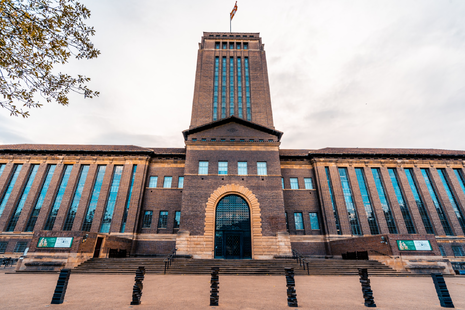The ‘magnificent erection’ of the University Library
Mia Apfel uncovers the story of the phallic monument

The phallic irony of the University Library’s architecture has not gone unnoticed since its construction. Praised as a “magnificent erection” by Neville Chamberlain, it seems that even the Prime Minister had caught onto the cheeky joke surrounding the 157 feet tall building. Students whisper legends of the tower’s pornographic stash: taboos hidden away in a location almost too on the nose to be true. Only secrets as racy as these might fracture the stiff-lipped world of Cambridge academia. But perhaps the penetration of the building’s double entendre has allowed its architectural history to go ignored?
Designed in the 1930s by Giles Gilbert Scott, architect of iconic London structures, from Battersea Power Station to the red telephone box, the library is characteristic of his modernist, industrial style. The eye meets a pristinely uniformed pattern. Sharp strips of window cut brown-red brick. Functionality is sovereign over every detail of Scott’s build; it is there in the clean lines, in the strong symmetry, in the continuous glass which blurs each floor into one exterior façade.
“Looming over an offspring of humanity subject libraries, the UL assumes an almost parental role: the colossal mother of lecture site buildings”
The library’s silhouette is one of deafening height, only accentuated by the modest size of the surrounding establishments. Looming over an offspring of humanity subject libraries, the UL assumes an almost parental role: the colossal mother of lecture site buildings. One might consider her the Maman of Sidgwick; to stand beneath the towering guardian provokes that same fear as is felt in facing Louise Bourgeois’ mammoth spider. And it is inside her deep womb where the bulk of Cambridge’s book collection is held.
Working on buildings of monumental scale was not an unfamiliar task for Scott. An “enjoyment of modelling in mass” became his hallmark, noted by The Times, in the year of the UL’s opening, as his “chief personal contribution to contemporary architecture”. Three years prior, he had worked on the external design of Battersea Power Station. Hired to appease concerns that the new factory would be a London eye-sore, Scott’s unusual ‘brick-cathedral’ style reworked public conception of what an industrial build ought to look like. The UL, while far off in its function from that of a power station, is similar in its silhouette. And its practical materials of steel and brick construct it as the close relative of Scott’s factory designs. Industrial image lingers in the form of this cultural powerhouse.
“The decorative, Catholic aesthetic would no longer appeal to the ‘modern’ eye, which had been trained to reject such traditional style”
Surprisingly, Scott’s entry into industrial design did not see him abandon his previous architectural experience. In the youth of his career, he had worked on religious structures, from Liverpool Cathedral to other Roman Catholic Churches across England. But, with the shift towards post-war secularism in the 1930s, Scott followed suit. The instrumental reasoning behind design had changed. Scott recognised that the decorative, Catholic aesthetic would no longer appeal to the ‘modern’ eye, which had been trained to reject such traditional style. Libraries, post-boxes, even college courts (he was also the architect for Clare College’s Memorial Court, which faces the UL), became his new focus. Yet Scott was not the blasphemous type; rather than a complete rejection of his architectural past, he included purposeful nods to his previous neo-Gothic style in his new designs. Scott’s architectural philosophy allowed him to bring the old into the new. In a revolutionary approach, he had blurred the boundary between warring architectural schools, using an alloy of traditional and modern to construct singular builds.
The UL, then, is not big for the sake of boasting size. Its infamous tower is not a mere phallic symbol, but a totem of the new industrial design which defined early 20th century architecture. Scott’s decision to withdraw from the world of religious buildings, instead dedicating his career to the construction of practical, public establishments, reflects a large-scale effort to organise and expand the intellectual sphere for future generations.
 News / SU reluctantly registers controversial women’s soc18 December 2025
News / SU reluctantly registers controversial women’s soc18 December 2025 News / CUP announces funding scheme for under-represented academics19 December 2025
News / CUP announces funding scheme for under-represented academics19 December 2025 Features / Should I stay or should I go? Cambridge students and alumni reflect on how their memories stay with them15 December 2025
Features / Should I stay or should I go? Cambridge students and alumni reflect on how their memories stay with them15 December 2025 Fashion / The art of the formal outfit 18 December 2025
Fashion / The art of the formal outfit 18 December 2025 Lifestyle / Summer lovin’ had me so… lonely?18 December 2025
Lifestyle / Summer lovin’ had me so… lonely?18 December 2025








